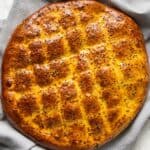Turkish Pide Bread - Ramazan Pidesi
Homemade pide bread made with instant yeast and topped with egg wash and sesame seeds.
- Prep Time: 15 minutes
- Cook Time: 25 minutes
- Total Time: 40 minutes
- Yield: 1 large loaf
- Category: Side Dish
- Method: Baking
- Cuisine: Turkish
Ingredients
Dough:
-
3 cup flour
-
1 teaspoon sugar
-
1 teaspoon salt
-
2 teaspoon instant yeast
-
3 tablespoons olive oil
-
1 cup lukewarm milk
-
2 and 1/2 tablespoon warm water
Topping:
-
1 egg yolk
-
1 tablespoon milk or yogurt
-
nigella seeds and sesame seeds
Instructions
- In a large bowl, whisk together flour, sugar, salt and instant yeast.
-
Add in olive oil and milk.
-
Gently mix with your hand.
-
Slowly add in water and keep mixing with your hand.
-
When it gets too sticky, slightly wet your fingertips and keep mixing. The result will be a sticky soft dough. Don’t knead it.
-
Grease the bottom and the edges of another bowl and transfer the dough into it. Cover it either with stretch film or a clean kitchen towel and let it rise. It takes between 40min-1.5 hours depending on the temperature.
-
Preheat the oven to 200C/400F. Line baking paper on a baking sheet. You can use a pizza pan or stone if you have it.
-
Gently release the air in the dough by turning it upside down in the bowl.
-
Transfer it onto the baking sheet and spread it in the pan, wetting your fingers occasionally and pressing on the dough. Give it a round or oval shape.
-
Wet your fingertips and make a circle on the dough leaving about 3cm from the edge. This will be the edge of the bread.
-
And then again with your fingertips make a diagonal pattern on it. It will rise when baking, and these patterns are likely to disappear. So press on the dough as much as you can when making the pattern. Let it sit for 15 min.
-
For the topping, whisk together the yogurt and egg well. Spread this mixture over the bread with a brush or your hand.
-
Sprinkle seeds over it and bake until golden, for about 20 minutes. Reduce the heat to 160C/320F and bake for another 5 minutes. Remove from the oven.
-
Transfer it on a clean kitchen towel. Cover it with a slightly dump kitchen towel and let it rest for 15 minutes. This will keep the bread softer.
-
After this time, slice and enjoy.
Nutrition
- Serving Size:
- Calories: 1918
- Sugar: 6.1 g
- Sodium: 2557.6 mg
- Fat: 58.1 g
- Carbohydrates: 298.6 g
- Fiber: 13.3 g
- Protein: 48.3 g
- Cholesterol: 184.8 mg
Find it online: https://www.giverecipe.com/turkish-pide-bread-recipe/
